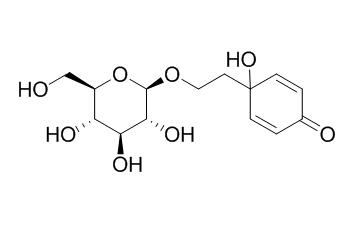Cornoside
Cornoside and Iridoids are chemosystematic markers.
Inquire / Order:
manager@chemfaces.com
Technical Inquiries:
service@chemfaces.com
Tel:
+86-27-84237783
Fax:
+86-27-84254680
Address:
1 Building, No. 83, CheCheng Rd., Wuhan Economic and Technological Development Zone, Wuhan, Hubei 430056, PRC
Providing storage is as stated on the product vial and the vial is kept tightly sealed, the product can be stored for up to
24 months(2-8C).
Wherever possible, you should prepare and use solutions on the same day. However, if you need to make up stock solutions in advance, we recommend that you store the solution as aliquots in tightly sealed vials at -20C. Generally, these will be useable for up to two weeks. Before use, and prior to opening the vial we recommend that you allow your product to equilibrate to room temperature for at least 1 hour.
Need more advice on solubility, usage and handling? Please email to: service@chemfaces.com
The packaging of the product may have turned upside down during transportation, resulting in the natural compounds adhering to the neck or cap of the vial. take the vial out of its packaging and gently shake to let the compounds fall to the bottom of the vial. for liquid products, centrifuge at 200-500 RPM to gather the liquid at the bottom of the vial. try to avoid loss or contamination during handling.
Evid Based Complement Alternat Med.2022, 2022:1307173.
Curr Issues Mol Biol.2022, 44(10):5106-5116.
Phytother Res.2019, 33(7):1784-1793
Neuroscience.2024, 559:77-90.
Food Chem X.2024, 21:101208.
Phytomedicine.2023, 117:154929.
Phytochem Anal.2024, pca.3319.
Biomolecules.2022, 12(12):1754.
Saudi Pharm J2020, 10.1016
Plants (Basel).2023, 12(5):1120.
Related and Featured Products
Arch Pharm Res. 2013 Sep;36(9):1104-12.
Analysis of the inhibitory activity of Abeliophyllum distichum leaf constituents against aldose reductase by using high-speed counter current chromatography.[Pubmed:
23645536]
METHODS AND RESULTS:
We isolated five phenolic glycosides (acteoside, eutigoside B, isoacteoside, rutin and Cornoside) from Abeliophyllum distichum leaves by high-speed counter current chromatography (HSCCC) using a solvent system of ethyl acetate:n-butanol:water (8:0.7:5). We determined the purity of the 5 compounds by high-performance liquid chromatography, and confirmed their chemical structures by using nuclear magnetic resonance data. We examined the inhibitory effect of these compounds on rat lens aldose reductase. Among these compounds, acteoside (1) showed the most potent inhibitory effect, with an IC₅₀ value of 1.39 μM. The inhibitory effect of 1 was 5.0 times greater than that of quercetin (7.05 μM), which was used as a positive control.
CONCLUSIONS:
These results suggest that acteoside may be a promising agent for the prevention or treatment of diabetic complications. Moreover, HSCCC is a promising method for the isolation and purification of biologically active compounds from natural products.
Biochemical Systematics & Ecology, 2005, 33(10):1031-1047.
Veronica: Iridoids and cornoside as chemosystematic markers.[Reference:
WebLink]
METHODS AND RESULTS:
The iridoid glucoside, ajugol, and the phenylethanoid glucoside, Cornoside, have been isolated from species of -esters of catalpol being universally present in 10 of the 12 subgenera for which data exist. Only the two subgenera -esters of catalpol, but ajugol instead. Veronica intercedens (subsect. Subracemosae) differs from the remainder of the subgenus in only containing 5-hydroxylated iridoids (melittoside and globularifolin) and is so far the only species within the genus in which such compounds have been detected. These chemical differences are clearly reflected in the DNA-based phylogram of the subgenus. Subg. Chamaedrys appears homogeneous in lacking iridoids or only containing these in small amounts, but instead half of the investigated species contained the phenylethanoid glucoside Cornoside.
CONCLUSIONS:
The distribution of this compound in angiosperms is reviewed; Cornoside often substitutes iridoid glucosides in plants where these are expected to be present. The chemical results of Veronica fit in very well with the phylogenetic implications of the DNA-sequence results.



